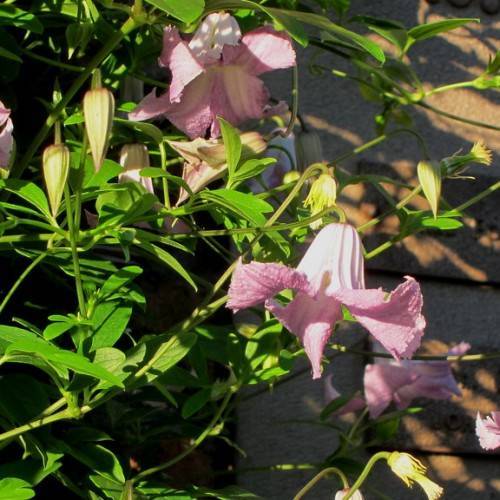
clematis
Clematis 'Betty Corning'
Cycle:
Perennial
Watering:
Average
Hardiness Zone:
4 - 9
Flowers:
Flowers
Sun:
Full sun,part shade
Leaf:
Yes
Growth Rate:
High
Maintenance:
Low
Care Level:
Medium
watering
The clematis (Clematis 'Betty Corning') should be watered deeply once a week during the growing season. Soak the soil thoroughly so that the water penetrates to a depth of 6-8 inches. Once established, the clematis should be able to tolerate short periods of dryness. During abnormally dry weather, water deeply every 5-7 days. Watering more frequently and lightly will not achieve the deep soaking needed to encourage a healthy and robust root system. Avoid overhead watering if possible, as wet foliage can be prone to disease, and take care not to get the new buds wet when watering. During the winter when the plant is dormant, reduce waterings to once every 2-3 weeks.
sunlight
Clematis 'Betty Corning' plants should receive direct sunlight for at least 4 to 6 hours a day. During particularly hot summer months, it is best to provide some sun protection, such as light shade, during the midday hours. This will help the plant keep its colorful foliage and flowers blooming more freely. It is important to water this plant deeply enough so that the entire root system receives adequate hydration, and then let the top 2 inches of soil dry out before watering again.
pruning
In general, pruning of Clematis 'Betty Corning' should take place in late winter, targeting just before any new growth begins. Pruning should be done sparingly, removing 1-third to 1-half of each stem back to a bud or node. Make sure to remove any dead, damaged, or diseased stems. Additionally, if the plant is a hybrid, prune to shape and to improve air circulation. This will help reduce problems with aphids and other pests. Avoid pruning flowering branches, as this will reduce the number of blooms you get.
Season
Hardiness Map
FAQ
Can Clematis plants grow in pots?
Yes, Clematis plants can definitely be grown in pots. When planting a Clematis in a pot make sure to use a larger size pot with drainage holes and fill it with a mix of well-draining potting soil and compost. Ensure to keep the root area cool and the pot in a sunny location while providing regular water and fertilization. Check the plant almost daily to make sure it is not becoming too dry. Clematis can do well in a pot and with the right care and conditions, they will thrive.
Are Clematis plants self-pollinating?
No, clematis plants are not self-pollinating. Clematis plants need pollinators such as bees, butterflies, moths and other insects to transfer pollen from the male anthers to the female stigma of the flower in order to produce viable seed. Pollination must also occur within relatively close proximity of the same species in order to create viable hybrid plants.
Can Clematis plants be grown as a houseplant?
Yes, Clematis plants can be grown as a houseplant. It is best to grow them in a pot with full sun and a soil that is rich in organic material and retains moisture. When potting the plant, place a stake or trellis next to the pot so that the vine can climb when it begins to grow. Be sure to water your Clematis plant regularly to keep it healthy and growing. Additionally, keep an eye out for pests and treat with natural insecticides as necessary.
Could Clematis plants survive in a colder climate?
Yes, Clematis plants can survive in colder climates with proper preparation. If planted in the fall, proper mulching should be done to protect the roots from cold temperatures. If planted in the spring, they should be watered frequently to help them adjust to the cooler temperatures more quickly. If temperatures drop below -20°C ( -4°F), additional measures may need to be taken such as the application of protective wraps and thermal insulation. Additionally, plants in exposed areas should be protected from the wind to prevent excessive dehydration. With the right measures in place, Clematis plants can easily survive in colder climates.
Could Clematis plants be grown in a greenhouse?
Yes, clematis plants can be grown in a greenhouse. Due to their vine-like growth habit and tropical native origins, clematis plants thrive in the moist and warm environment of a greenhouse. Clematis are generally grown from cuttings or from dividing existing plants, and benefit from regular pruning and fertilizing. They will also enjoy the indirect light of a greenhouse and the protection from strong winds and temperatures that the humidity and contained environment provides.
